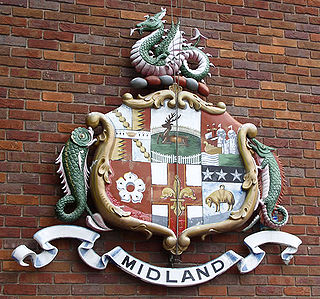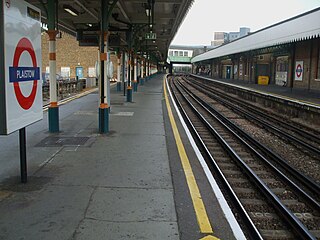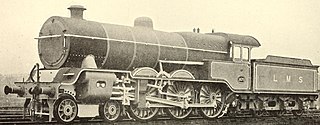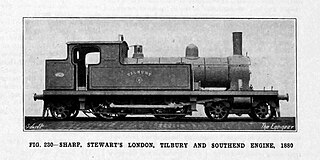
The Locomotives of the Midland Railway, followed its small engine policy. The policy was later adopted by the London, Midland and Scottish Railway, and contrasted with the London and North Western Railway's policy. The small engine policy was partly the consequence of a difference in the background of senior managers. In most railway companies, the elite position was the design, construction and maintenance of locomotives. Bigger engines brought more prestige and allowed longer trains. In the Midland, the marketing department was paramount. They recognised that people wanted more frequent, shorter trains rather than an infrequent service. It concentrated on very light, very fast and frequent trains.
The London, Midland and Scottish Railway had the largest stock of steam locomotives of any of the 'Big Four' Grouping, i.e. pre-Nationalisation railway companies in the UK. Despite early troubles arising from factions within the new company, the LMS went on to build some very successful designs; many lasted until the end of steam traction on British Railways in 1968. For an explanation of numbering and classification, see British Rail locomotive and multiple unit numbering and classification.

The London, Tilbury and Southend line, also known as Essex Thameside, is a commuter railway line on the British railway system. It connects Fenchurch Street station, in central London, with destinations in east London and Essex, including Barking, Upminster, Basildon, Grays, Tilbury, Southend and Shoeburyness.

Plaistow is a London Underground station on Plaistow Road in the London Borough of Newham in Greater London. It is between West Ham and Upton Park stations on the District and Hammersmith & City lines, and in Travelcard Zone 3.
Robert John "Bob" Essery was a British railway modeller and historian with a particular interest in the London Midland and Scottish Railway (LMS) and one of its principal constituents, the Midland Railway (MR).
A number of different numbering and classification schemes were used for the locomotives owned by the London, Midland and Scottish Railway (LMS) and its constituent companies; this page explains the principal systems that were used.

The Midland Railway 483 Class 4-4-0 was a class of steam locomotive designed by Henry Fowler for passenger work on the Midland Railway. The class were nominally "rebuilds" of various earlier classes designed by Samuel W. Johnson, although the '483' class engines were, unquestionably, 'accountancy rebuilds'
. This design formed the basis for the later LMS Class 2P 4-4-0.

The Lancashire and Yorkshire Railway (L&YR) Class 8 was a four-cylinder 4-6-0 express passenger locomotive designed by George Hughes introduced in 1908.
The Midland Railway Johnson 0-6-0 were a class of locomotives serving Britain's Midland Railway system in the late 19th and early 20th centuries. Between 1875 and 1908 the Midland Railway, under the control of locomotive superintendents Samuel Waite Johnson and Richard Deeley, ordered 935 goods tender engines of 0-6-0 type, both from the railway's own shops at Derby and various external suppliers. Although there were many variations between different batches both as delivered and as successively rebuilt, all 935 can be regarded as a single series, one of the largest classes of engine on Britain's railways. The locomotives served as late as 1964, but none of them now survive.
The London, Tilbury and Southend Railway 51 class was a class of 4-4-2T steam locomotives. Twelve were built by Sharp, Stewart and Company to the design of Thomas Whitelegg for the London, Tilbury and Southend Railway in 1900, with North British Locomotive Company supplying an additional six in 1903. The LTSR numbered them 51–68, and named them places in London and Essex.
The London, Tilbury and Southend Railway (LT&SR) 2100 Class was a class of 4-6-4T steam locomotives. Eight were built in 1912, the year the Midland Railway took over the LT&SR, to the design of Robert Harben Whitelegg. Hence, they were numbered in the Midland numbering system as 2100–2107, and none received a name. The Midland gave them the power classification 3P. All subsequently passed into LMS ownership in 1923. They were all withdrawn 1929–1934, and all were scrapped.
Locomotives of the London, Tilbury and Southend Railway. Initially, the London, Tilbury and Southend Railway (LTSR) hired Eastern Counties Railway (ECR) locomotives and then after the amalgamation of that railway into the Great Eastern Railway (GER), locomotives from that company were hired. In 1880 the company bought its first locomotive saving on hiring costs from the GER and further engines followed that year. The LTSR principally operated tank engines, which it named after towns on the route. The railway's first locomotive superintendent was Thomas Whitelegg, who in 1910 was succeeded by his son Robert. The LTSR became part of the Midland Railway (MR) in 1912, but nevertheless continued to be operated independently. The Midland removed locomotive names and renumbered engines. The Midland, and its successor the London, Midland and Scottish Railway (LMS), continued to build some designs.

The LT&SR 69 class was a class of 0-6-2T steam locomotives designed for freight work on the London, Tilbury and Southend Railway. Six were initially built in 1903 to the design of Thomas Whitelegg, four more followed in 1908, and a further four in 1912, after the LT&SR's takeover by the Midland Railway (MR) in that year, giving a total of 14. The Midland renumbered them 2180–2193, and all entered LMS stock upon the grouping of 1923. The LMS renumbered them 2220–2233 in 1923, but then took them back to 2180–2193 in 1939. In 1947 they were again renumbered 1980–1993 by the LMS, and in 1948 all were acquired by British Railways. BR added 40000 to their numbers so they became 41980–41993. Withdrawals started in 1958, and by 1959 all but 41981 had gone. The last engine was withdrawn in 1962, and none of the small fleet were preserved.
The LT&SR 49 class was a class of 0-6-0 steam locomotives. They were the only tender engines used by the London, Tilbury and Southend Railway. They were originally ordered by the Ottoman Railway in Turkey, however that order was cancelled after they had been built and instead they were sold to the LT&SR in 1898. The LT&SR numbered them 49 and 50.

The Midland Railway 1252 class was a class of thirty 0-4-4T locomotives built by Neilson and Company in 1875–1876 to the design of Samuel Waite Johnson. They were a development of the 6 Class. Originally numbers 1262–1281 and 1252–1261. Under the Midland Railway's 1907 renumbering scheme they became 1236–1265.
The LTSR 37 class was a class of 4-4-2T suburban tank engines built for the London, Tilbury and Southend Railway in 1897–98. They were designed by Thomas Whitelegg as a development of the earlier LT&SR 1 Class.

The London, Tilbury and Southend Railway 1 class was a class of 4-4-2T suburban tank engines. Thirty-six were built between 1880–1892, by Sharp, Stewart and Company and Nasmyth, Wilson and Company. They were the first locomotives owned by the London, Tilbury and Southend Railway and were the first 4-4-2T locomotives to operate in Britain.

The London and North Western Railway (LNWR) Class G2 is a class of 0-8-0 steam locomotives. 60 were built at Crewe Works in 1921–1922. Uniquely amongst classes of LNWR 8-coupled tender engines, they were not rebuilt from or into other classes. Somewhat confusingly, the LNWR Class G2a is sometimes considered a subclass, but not in this article. They were classified by the London, Midland and Scottish Railway (LMS) as 5, from 1928 7F.
The London, Tilbury and Southend Railway (LT&SR), was a British railway company, whose network connected Fenchurch Street station, in central London, with destinations in east London and Essex, including Barking, Upminster, Grays, Tilbury, Southend and Shoeburyness. The company and its assets were sold to the Midland Railway in 1912. The network over which they operated is largely intact and is currently operated as part of the Essex Thameside franchise.
The Glasgow and South Western Railway 540 Class were 4-6-4T steam tank locomotives designed by Robert Whitelegg and built in 1922, shortly before the G&SWR was absorbed into the London, Midland and Scottish Railway (LMS). They were referred to in official G&SWR publicity as the Baltic Class, although they were also known more prosaically to enginemen as the 'Big Pugs'.










